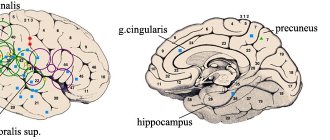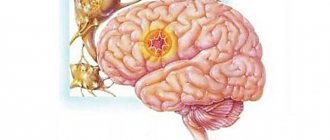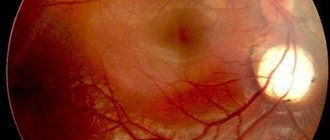Definition of frontal lobe epilepsy
Frontal epilepsy is one of the forms of epilepsy, accompanied by seizures, the focus of which is located in the frontal regions of the brain. Frontal lobe epilepsy is the second most common and accounts for approximately 30% of other forms.
Frontal lobe epilepsy can develop at any age. The likelihood of developing this form of epilepsy is the same in men and women.
Features of a frontal epileptic seizure:
- A motor phenomenon that is accompanied by gestural automatisms at the beginning of an attack. There are tonic, clonic and postural;
- The attack lasts several seconds;
- Rapid secondary generalization, observed more often during temporal lobe seizures;
- Minimal or complete absence of postictal confusion;
- Attacks occur frequently, mostly occurring at night. Consciousness may be preserved or partially impaired. The clinical pattern of a seizure depends on the location of the lesion.
Diagnosis of temporal lobe epilepsy
The success of treatment for temporal lobe epilepsy largely depends on timely diagnosis. If signs of the disease appear, you should consult a specialist - a neurologist-epileptologist. The best option would be to visit a doctor with a loved one, who can give a more accurate description of the seizures observed in a patient with temporal lobe epilepsy. After consultation, the doctor prescribes a number of tests and procedures necessary for further diagnosis.
As with symptoms, the process for diagnosing temporal lobe epilepsy in adults and children is different. The difficulty of identifying the disease in older patients is that they seek help only when secondary generalized attacks occur. Patients often classify simple partial seizures as a common ailment. Even complex epileptic seizures are not regarded by them as a reason to see a doctor. A significant proportion of early diagnoses of “temporal lobe epilepsy” relate to childhood, since medical consultation is carried out on the initiative of parents who are concerned about deviations in the child’s development.
Often temporal lobe epilepsy in adults does not manifest itself in any way. Corresponding neurological signs occur only if the epileptic focus in the temporal lobe was provoked by a cerebral hematoma, tumor, stroke or injury. Children are characterized by microfocal symptoms in the form of increased activity of tendon reflexes and mild coordination disorders. With long-term progression of temporal lobe epilepsy without treatment, personality disorders begin to appear.
Even if there is a pathological focus, it is quite difficult to detect it on an electroencephalogram. To detect epileptic activity, polysomnography is often used - an EEG is performed on the patient while he is sleeping.
The most accurate method of functional diagnosis of temporal lobe epilepsy is MRI of the brain. As a result of the examination, the exact location of the lesion can be recorded. MRI often reveals medial temporal sclerosis. Thanks to this method, it is possible to diagnose many other injuries of the temporal lobe:
- tumors;
- cortical dysplasia;
- cysts;
- vascular malformations;
- atrophic disorders of the temporal zone.
To detect metabolic imbalances in the temporal lobe in epilepsy, a PET scan of the brain is performed.
Diagnosis of frontal lobe epilepsy
Diagnosis of this type of epilepsy is carried out using MRI. Magnetic resonance imaging reveals the focus of pathology in 60% of cases. Functional neuroimaging methods are also used to help achieve focus localization. Interictal and ictal EEG results will usually be normal.
In most cases, the prognosis for the frequency of attacks during treatment is not encouraging.
The probability of erroneous differential diagnosis is very high - hypermotor seizures are regarded as psychogenic seizures, familial paroxysmal dystonic choreoathetosis, paroxysmal kinesiogenic choreoathetosis, episodic ataxia. Due to similar clinical manifestations and EEG characteristics, symptomatic frontal absence seizures are mistakenly classified as typical absence seizures.
Prognosis of temporal lobe epilepsy
The further development of temporal lobe epilepsy depends on the causes of the appearance of the epileptic focus, as well as the severity of brain damage. In most cases, the prognosis is quite serious, since attacks tend to progress from complex partial to simple and vice versa. If temporal lobe epilepsy was provoked by an external factor and was accompanied by frequent seizures leading to mental disorders, then such a disease is characterized by a negative prognosis. There is a very high probability that the symptoms will only increase and the attacks will become even more pronounced.
Drug therapy can reduce the frequency of epileptic seizures, but complete remission can be achieved only in 30-35% of cases. In most adult patients, attacks never stop, which leads to difficult adaptation of patients in society.
Surgical treatment also does not provide any guarantees. In addition, surgery poses a risk for patients with complex seizures. The danger lies in the occurrence of complications such as:
- reversible and irreversible loss of speech;
- partial or complete blindness;
- memory impairment;
- distortions of tactile, visual and auditory perception;
- change in character and psycho-emotional state.
But the above concerns are associated with severe cases of temporal lobe epilepsy. For many patients scheduled for surgery, doctors give an encouraging prognosis. Complete cessation of attacks after surgical treatment is observed in 30-50% of patients, and in 60-70% of patients there is a significant reduction in the frequency of their occurrence.
Causes and symptoms of frontal lobe epilepsy
The clinical symptoms of frontal lobe epilepsy are determined by the zone of irritation, on the basis of which the following forms are distinguished:
- Motor form, which is accompanied by convulsions in the half of the body that is opposite to the lesion;
- Dorsolateral paroxysms, which are expressed by a sharp unnatural turn of the head and eyes in the direction that is also opposite to the focus of the pathology;
- Orbitofrontal paroxysms, manifesting as cardiovascular, respiratory and epigastric attacks. In this case, it is possible to record pharyngeal-oral automatisms, which are accompanied by copious secretion of saliva;
- Frontopolar seizures associated with mental dysfunction;
- Cingular seizures that disrupt a person’s behavior and expression of emotions;
- Seizures arising from the supplementary motor area of the brain. Paroxysms from different parts of the frontal lobe of the brain can spread to the supplementary motor area. In this case, the patient suffers from nocturnal simple partial seizures. Seizures alternate with archaic movements and hemiconvulsions. Often an epileptic seizure is accompanied by aphasia. Aphasia is a disorder of the speech apparatus, and occurs due to damage to certain areas of the cerebral cortex. Accompanied by strange sensations in the torso, arms and legs. In addition, tonic convulsions appear alternately in one half or throughout the entire body.
- “Inhibitory” seizures and paroxysmal hemiparesis are rare phenomena accompanied by paroxysms of archaic movements, which often occur at night. These seizures can happen up to 10 times a night and repeat every night.
Causes of temporal lobe epilepsy
The occurrence of temporal lobe epilepsy can be triggered by a number of different factors. They can be divided into two groups:
- Perinatal. These include those that affect the fetus at the stage of its intrauterine development. These also include generic influence factors. The impetus for the development of temporal lobe epilepsy can be trauma received during childbirth, oxygen starvation of the fetus, various intrauterine infections such as measles, rubella, syphilis and others, as well as asphyxia of the baby at the time of birth.
- Postnatal. These developmental mechanisms imply the occurrence of epileptic activity due to severe traumatic brain injury and infections affecting the central nervous system. This group of factors also includes hemorrhagic and ischemic stroke. Also, the progression of the disease is facilitated by brain lesions such as large tumors, hematoma, cerebral aneurysm, sclerosis and abscess.
In more than half of cases, the disease develops due to medial temporal sclerosis. This disease can either cause epilepsy or be a consequence of prolonged convulsive seizures. Its essence lies in a destructive process in which neurons die, which leads to scarring of the deep part of the temporal zone. The clinical picture of the pathology is varied, but the most characteristic sign is febrile convulsions. In medicine, they are considered one of the most dangerous mechanisms for the development of temporal lobe epilepsy. Febrile seizures are tonic-clonic or tonic tremors in the limbs, occurring in the form of seizures at a body temperature of 37.8-38.5. Most often observed in children of various age groups.
There is also a direct connection between the severity of the disease and the lack of Reelin, a protein that regulates the positioning of neurons. It is convulsions with a long duration that provoke its loss.
Clinical picture
The main clinical sign of temporal lobe epilepsy is epileptic seizures. They arise suddenly and are expressed in the patient’s unconsciousness, loss of orientation, muscle cramps, etc. In this case, a characteristic feature is the fact that during a seizure the patient turns his head and squints his eyes towards the temple in which the area of epileptic activity is concentrated.
Other symptoms of temporal lobe epilepsy include:
- frequent, even systematic dizziness;
- headaches and migraines;
- visual and auditory hallucinations;
- olfactory paroxysms;
- squeezing or bursting sensation in the heart area;
- coordination problems;
- various forms of mental disorders;
- automation of gestures and sounds;
- personality distortions, etc.
Features of the disease
In medical practice, epilepsy is a complex neurological disease accompanied by sudden seizures and seizures. The disease is characterized by the fact that during an attack a person does not realize what is happening to him. As a result, patients do not remember the seizures, do not understand the degree of their intensity and are not able to describe what happened to them.
Temporal lobe epilepsy is one of the most common forms of the disease. This type of disease is accompanied by partial epileptic seizures of varying severity. The progression of pathology in the absence of adequate therapy threatens the occurrence of generalized seizures, as well as the development of various mental disorders and deformations.
There is also a classification of temporal lobe epilepsy, according to which there are 4 types of pathology, depending on the location of the epileptic focus:
- amygdala;
- hippocampal;
- lateral;
- opercular.
Read also
Epilepsy
These are epileptic seizures that occur repeatedly, regardless of any cause, and are associated with chronic illness of the cerebral cortex.
Epilepsy is a very common disease. Approximately… Read more
Treatment of epilepsy in Samara
Epilepsy therapy is a long process and requires interaction between the epileptologist and the patient. Currently, it is possible to stop attacks and achieve remission in 60%! How to do it? Basic…
More details
Alcoholic epilepsy
In accordance with the International Statistical Classification of Diseases developed by the World Health Organization, alcoholism is considered a “dependence syndrome” and is included in the section of behavioral,…
More details
Causes of epilepsy
“Where did my seizures come from? There are no epileptics in our family!” - the most common phrase at the reception, we will tell you about the causes of epilepsy. Indeed, up to 70% of all epilepsies are genetically predetermined...
More details
Symptoms of epilepsy
How does epilepsy manifest? The most “famous” epileptic attack is a convulsive one, as the most “bright” one, this attack includes general tonic-clonic seizures, blueness of the face, salivation, ...
More details







